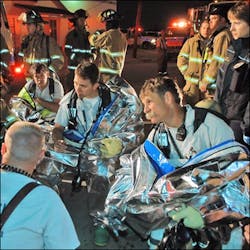Over the years, as I would train new people, and even conduct the training for long-time team members I would frequently run into hazmat team personnel who had the proverbial appearance of the “deer in the headlights” look. I surmised this was for several reasons. Some people are just not interested in hazmat response, and I found they would soon exit the team at their earliest convenience. Some of them were merely in it for the extra pay incentive and after a few sweaty sessions in Level A suits, or after a hairy call or two, their true intentions were exposed and they would quit. Another reason for looking like a deer on the highway at night was that the myriad of information, and the things that need to be considered, was just too overwhelming for many people.
These people would more than likely hang around longer though, and they tended to follow others blindly, but they did what they were directed to do by others who “got it.” The last group who acquired the dazed-deer look usually got it from “analysis paralysis” or simply, information overload. This was easy to get because of the way most teams handle the task of research within the team environment. The following concepts are more general precursors as to why hazmat team personnel become blinded deer, along with ways to avoid this common hazmat team malady.
Avoid Teaching Formal Chemistry
Most hazmat teams believe that their team members need to have formal chemistry training. Consequently, many teams have had high school or college-level instructors teach full-length chemistry courses to their team. This is a colossal waste of time! My experience is that team members will endure the course, do their best on the final test, and then expunge everything they learned as soon as the course ends. I can attest that as soon as the word “chemistry” is muttered most of the hazmateers that are present drift into an “eyes-wide-open” state of sleep. Then, it is all downhill from there!
Simply stated, hazmat team members do not need to know anything about electrons, neutrons, protons, and atomic structure. Nor do they need to know about balancing equations, covalent or ionic reactions, or the duet or octet law. All of this only serves to complicate the issue and confuse most responders. Now, if responders come to the team with this education and training that is a good thing! But, it is surely a waste of time and money to insist that all team members have formal chemistry training.
What is needed is training on nomenclature with chemical compounds and then what the corresponding hazards are based on the chemical compound name. In the previously mentioned “analysis paralysis” affliction, what happens is that chemistry information confounds the researcher due to trying to figure out the components of the compound, the bonds that are formed, and the structural diagram of the compound. In 20 years of hazmat response, I have not needed to consider any of that chemistry information at a hazmat incident.
State of Confusion
Another common problem in research is that responders can get hung up on seeing an element’s name in the compound name. I have repeatedly observed responders do the following: in a compound name such as “potassium chloride” the focus would be that potassium is a water-reactive metal that can be almost explosive. Of course, this is not the case, because the elemental potassium has undergone an ionic transformation and is now in a fairly stable compound. Potassium chloride is a “salt” that is even used to salt food for human intake; hardly the explosive, water-reactive compound that the researcher identified. All of that formal chemistry only added to a state of confusion once the responder got to the field.
What is needed is training that is geared toward the compound’s chemical and physical hazards based on its name. Potassium chloride is a salt compound that is water soluble and caustic when wet. It is also non-flammable and does not form a gas. All of this is based on the compound and can be derived from its nomenclature through a very simple training session. For emergency response, there are very few hazards that need to be researched. Hazards such as flashpoint, boiling point, vapor pressure, water solubility, vapor density, and flammable range are some of the important parameters to research. Application of that data to the field, with current environmental conditions considered, is then the key as far as response actions. Conversely, responders do not need to know the latent heat of vaporization, what the compound does to snail darters in water, or other non-emergency parameters, as examples. Yet, some teams still insist that a lengthy, multi-page research document, loaded with non-pertinent information, needs to be completed at each incident. This is sheer lunacy!
Research is never ending
The last deer-in-the-headlight affliction occurs because the “research” role goes on and on. In this day of information availability, the tendency is to continue to research as long as possible for more, or new, information. This is because our information sources are endless and readily available. We can now go online and retrieve information from subscription sources, governmental sources, and chemical manufacturing sources, all at remote locations. As reams of information are printed out, the research person may even highlight pertinent information, and send it on to decision makers, who in turn get overwhelmed due to the volume of information. This is pure insanity and few teams overcome the problem.
There are really only two things need to be done. The first one is to research before the incident occurs and record the important items, recalling the information when needed at the time of the emergency. A form can be filed, either electronically or in hard copy, that records the important chemical and physical properties, the suits, boots, and gloves that are needed, and the recommended control measures for the actual handling of the release. Pre-information sources can be researched through the local LEPC, emergency government, and local chemical companies. Since mostly bulk chemicals are transported to and through each community, the list should be no secret, and most likely these common community chemicals will be your next emergency. Secondly, doing this pre-information recording also frees up the research person to do other tasks at emergencies.
Certainly, there are other hazmat team dysfunctions to address, but, tackling the above will help in getting, and retaining, the right people for the team. If done correctly, training can become more efficient and valuable funds can be spent elsewhere. The end result is that you’ll have less “deer in the headlights” personnel and more who’ll perform their tasks confidently and comfortably, and even become long-time, productive team members.
“It is not necessary to change. Survival is not mandatory.” -W. Edwards Deming
DAVID PETERSON, a Firehouse.com Contributing Editor, is a 31-year veteran fire officer. He is a graduate of the National Fire Academy's Executive Fire Officer Program and has a B.S. degree in fire service management from Southern Illinois University. David is also a graduate student in leadership with Grand Canyon University. View all of David's articles here and the articles he co-authors with Joseph L. Krueger here. You can reach David by e-mail at [email protected].
About the Author

David F. Peterson
David F. Peterson, MS, EFO, is a 35-year veteran of the fire service and a retired Wisconsin fire chief. He is currently a fire training coordinator for Blackhawk Technical College in Janesville, WI. Peterson has served as a company officer, training officer, hazmat team leader, chief officer and incident commander. He is a past board member for the Wisconsin State Fire Chiefs Association, a national presenter on fire service and hazmat topics, and he founded the Wisconsin Association of Hazardous Materials Responders in 1992. Peterson has a master’s degree in executive fire leadership and disaster preparedness from Grand Canyon University and a bachelor’s degree in fire service management from the University of Southern Illinois. He is also a graduate of the National Fire Academy’s Executive Fire Officer Program. He is a principal partner of White Helmet Innovations, LLC.
